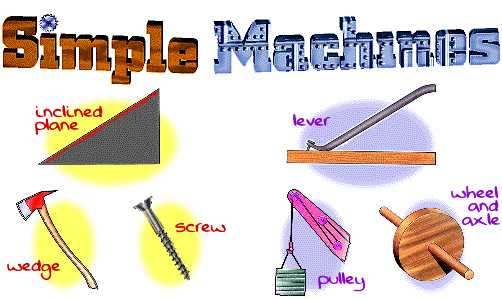

In science, work is defined as a force acting on an object to move it across a distance. Pushing, pulling, and lifting are common forms of work. Furniture movers do work when they move boxes. Gardeners do work when they pull weeds. Children do work when they go up and down on a see-saw. Machines make their work easier. The furniture movers use a ramp to slide boxes into a truck. The gardeners use a hand shovel to help break through the weeds. The children use a see-saw to go up and down. The ramp, the shovel, and the see-saw are simple machines.
A machine is a tool used to make work easier. Simple machines are simple tools used to make work easier. They have few or no moving parts. There are 6 simple machines: Inclined Plane, Wedge, Screw, Lever, Wheel and Axle, and Pulley.
Compound machines have two or more simple machines working together to make work easier. Most of the machines we use today are compound machines, created by combining several simple machines.
Take the simple machine quiz.
For more information about simple machines, browse this website.
To find out how some compound machines work, check out this popular website.
 Inclined
Plane
Inclined
Plane
A
plane is a flat surface. For example, a smooth board is a plane. Now, if the
plane is lying flat on the ground, it isn't likely to help you do work. However,
when that plane is inclined, or slanted, it can help you move objects across
distances. And, that's work! A common inclined plane is a ramp. Lifting a heavy
box onto a loading dock is much easier if you slide the box up a ramp--a simple
machine.
 Wedge
Wedge
Instead of using the smooth side of the inclined plane, you can also use the pointed edges to do other kinds of work. For example, you can use the edge to push things apart. Then, the inclined plane is a wedge. So, a wedge is actually a kind of inclined plane. An axe blade is a wedge. Think of the edge of the blade. It's the edge of a smooth slanted surface. That's a wedge!
![]() Screw
Screw
Now, take an inclined plane and wrap it around a cylinder. Its sharp edge becomes another simple tool: the screw. Put a metal screw beside a ramp and it's kind of hard to see the similarities, but the screw is actually just another kind of inclined plane. Try this demonstration to help you visualize. How does the screw help you do work? Every turn of a metal screw helps you move a piece of metal through a wooden space. And, that's how we build things!
 Lever
Lever
Try pulling a really stubborn weed out of the ground. You know, a deep, persistent weed that seems to have taken over your flowerbed. Using just your bare hands, it might be difficult or even painful. With a tool, like a hand shovel, however, you should win the battle. Any tool that pries something loose is a lever. A lever is an arm that "pivots" (or turns) against a "fulcrum" (or point). Think of the claw end of a hammer that you use to pry nails loose. It's a lever. It's a curved arm that rests against a point on a surface. As you rotate the curved arm, it pries the nail loose from the surface. And that's hard work!
 Wheel
and Axle
Wheel
and Axle
The rotation of the lever against a point pries objects loose. That rotation motion can also do other kinds of work. Another kind of lever, the wheel and axle, moves objects across distances. The wheel, the round end, turns the axle, the cylindrical post, causing movement. On a wagon, for example, the bucket rests on top of the axle. As the wheel rotates the axle, the wagon moves. Now, place your pet dog in the bucket, and you can easily move him around the yard. On a truck, for example, the cargo hold rests on top of several axles. As the wheels rotate the axles, the truck moves. You can move your dog across the country!
 Pulley
Pulley
Instead of an axle, the wheel could also rotate a rope or cord. This variation of the wheel and axle is the pulley. In a pulley, a cord wraps around a wheel. As the wheel rotates, the cord moves in either direction. Now, attach a hook to the cord, and you can use the wheel's rotation to raise and lower objects. On a flagpole, for example, a rope is attached to a pulley. On the rope, there are usually two hooks. The cord rotates around the pulley and lowers the hooks where you can attach the flag. Then, rotate the cord and the flag raises high on the pole.